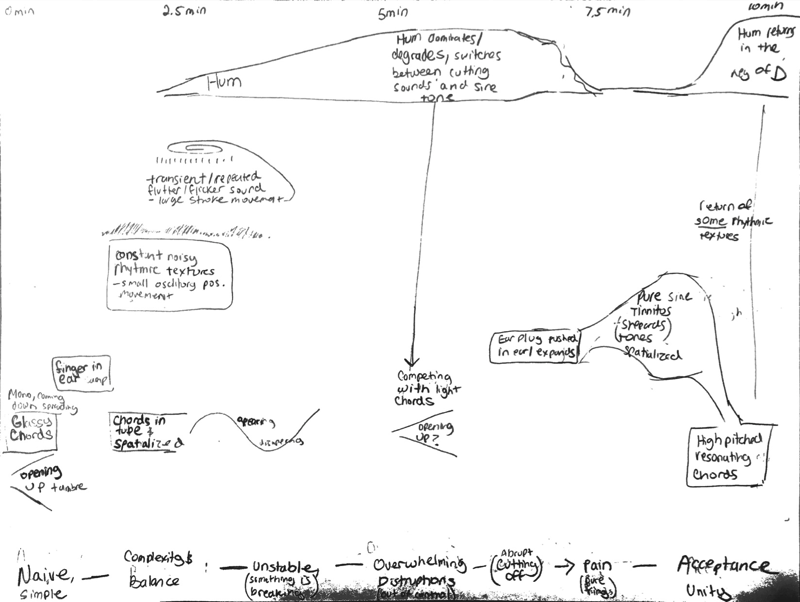Difference between revisions of "HeadSpace"
| Line 5: | Line 5: | ||
Bin Ring24 - 3h0v Binaural Mix: https://soundcloud.com/vicmeisterin/headspace-3h0v-binaural-mix | Bin Ring24 - 3h0v Binaural Mix: https://soundcloud.com/vicmeisterin/headspace-3h0v-binaural-mix | ||
| − | |||
| + | ''Featuring: | ||
| + | '' | ||
Paul Batchelor's musical programming language: Sporth | Paul Batchelor's musical programming language: Sporth | ||
Revision as of 19:31, 11 June 2017
HeadSpace: A piece about tinnitus and distractions.
Bin Octagon - 3h0v Binaural Mix: https://soundcloud.com/vicmeisterin/headspace-bin-octagon-3h0v-binaural-mix
Bin Ring24 - 3h0v Binaural Mix: https://soundcloud.com/vicmeisterin/headspace-3h0v-binaural-mix
Featuring:
Paul Batchelor's musical programming language: Sporth
Alex Chechile’s Ear Tone Toolbox for Auditory Distortion Products
Ambix 3.1 Ambisonics plugins It can be divided into different sections in the following progression: Naïve/ Simplicity > Complex/ Balance > Growing instability > Overwhelming disruptions > Dramatic cutoff > Pure pain > Acceptance and Unity.
Naïve/ Simplicity is characterized by simple arpeggiating chords from a modular synth recording of arpeggiated triplets in 12/8. It begins in stereo, from two mono recordings made through a tube (roughly the diameter of the ear canal) with a small microphone inserted at the base. This effect was intended to emulate the sound of fingers going in ears, checking for a hissing sound. This mono source spreads out spatially but remains a single source.
Complexity/ Balance is a rhythmic section with similar harmony as the opening but in a more complex form, with different parts of the spectrum appearing and disappearing in different locations creating a calm atmosphere. The ambient sounds are accompanied by unpitched noisy, rhythmic, textures in the same 12/8 meter, wander slightly but stay relatively in the same place. There are also be transient clicks which move as mono sources in larger strokes reminiscent of John Chowning's Turenas.
Growing Instability can be marked by the entrance of a low hum of about 40 Hz with a rhythmic quality that starts to creep in from location then spreads to different locations, taking a slightly different form. The sound is characterized of a spreading speaker deterioration in different locations, dominating over the meditative, tonal music. As the hum grows more present, it begins to deteriorate with a gating effect, switching drastically between sharp, ripping, cutting sounds and a sine tone at 1000 Hz. This uncomfortable, hectic, sound gets louder and more sporadic and explosive until it is suddenly cut off with the presence of a scream (recording of Yuval Adler yelling "Quiet" in a reverberant stairwell).
Pain follows the explosive sounds characterized by pure auditory distortion product tones made from by high frequency tones with ratios that cause a phantom tone of the root note of the original key of the beginning in the piece. At this point, dramatic timbre changes can be experienced by small head movements. The effect is most present in the live, spatialized listening setting. Out of the high pitched ring, emerges twinkling, resonating chords referencing the same progression as earlier in the song. These tones fuse with the ringing and phantom tone heard in ones head (Acceptance).
Disrupting hum example: https://soundcloud.com/vicmeisterin/hum1
Original Score:
Sources:
F. Rumsey, S. Zielinski, R. Kassier, S. Bech, "On the relative importance of spatial and timbral fidelities in judgments of degraded multichannel audio quality", The Journal of the Acoustical Society of America, vol. 118, pp. 968-976, 2005.
Sound Synthesis with Auditory Distortion ProductsGary S. Kendall; Christopher Haworth; Rodrigo F. CádizComputer Music JournalYear: 2014, Volume: 38, Issue: 4Pages: 5 - 23, DOI: 10.1162/COMJ_a_00265
Sinusoidal Burst Generator for Auditory Evoked Response ResearchV. Klig; S. Beitler; E. StephensonIEEE Transactions on Biomedical Engineering
The relationship between EEG and binaural beat stimulation in meditationT. Yamsa-ard; Y. WongsawatThe 7th 2014 Biomedical Engineering International Conference
